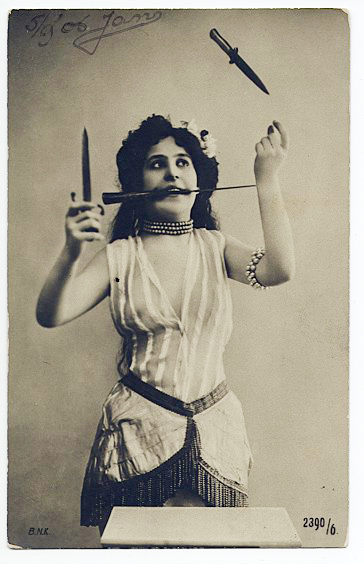
One of the earliest was W. H. Bell’s circus, but by the eighties there were several, including Feeley’s, Wirth’s, Cooke’s, Val Simpson’s and that of the incomparable Frank Fillis who, coming to South Africa in 1880 to join Bell’s circus, took it over when Bell died. The two mining towns, Kimberley and Johannesburg, and the seaports of Cape Town and Durban now provided profitable ‘pitches’, and the smaller inland towns, formerly almost completely Fillis’s Circus building, Cape Town, in 1895 without entertainment, constituted a worth-while ‘circuit’.
Going overseas from time to time in order to recruit his ‘turns’, Fillis developed his circus into a major entertainment which the highest in the land were glad to patronise. He established a permanent building in Johannesburg in 1889 known as ‘Fillis’s Amphitheatre’ and specialised in spectacles such as a reconstruction of the Niagara Falls, ‘Dick Turpin’s ride to York’ and ‘Major Wilson’s last stand’. These were also staged at a structure opened in 1896 in Cape Town at the foot of Adderley Street alongside the Pier. Madame Fillis was an equestrienne of note and performed haute école at a benefit night given in Johannesburg in 1895. Mr. Lionel Phillips presented Mr. Fillis with a set of diamond studs and Madame Fillis with a ruby and diamond brooch on behalf of Johannesburg residents.
The artistes and company presented him with a gold star set with diamonds’. In spite of the high tone and spectacular scope of his performances, Fillis was frequently in financial straits. In 1900 he took an extraordinary show entitled ‘Savage South Africa’ to England, but despite the attraction of an authentic South African stagecoach, black warriors and other novelties, it failed and he was again bankrupt. He was reintroduced grandly to his old South African pitch by the impresario A. Bonamici in 1902 with an ‘Imperial Circus’, but the current depression militated against him. He faced bankruptcy again and again, and his animals were once sold over his head to pay his creditors.
 Finally ‘Madame Fillis’s Circus and Wild West Show’ went into opposition against him in Durban in 1910. (Vincenta Fillis, once the world’s first ‘human canon-ball, died in Durban in May 1946 at the age of 75.) Frank Fillis, with the circus that had become a national institution, then left South Africa and operated in the East. He died in Bangkok in Jan. 1922, but his sons continued in the entertainment field. The eldest, Frank, a well-known cinema manager, died in Johannesburg at the age of 80 in March 1961. During the acute depression that followed the Second Anglo-Boer War the circus was often the only entertainment in the large towns. In addition to Fillis, Bonamici himself, Blake, Willison, Bostock and Wombwell, and F. W. A. Pagel toured during this period. Pagel and his wife survived many vicissitudes to become as much a national institution as Fillis. Born in Pomerania, Wilhelm Pagel was a professional weight-lifter, wrestler and lion-tamer. Madame Pagel also performed with the lions and tigers in her earlier days. Later she left the ring to undertake the entire direction of the complex circus organisation. She was known all over South Africa and frequently caused a sensation by driving about in the streets in an open car with a fully-grown lion beside her. She died at the Pagel training farm for animals near Pretoria in December 1939. The circus continued even after her husband retired in 1944 and after his death at Knysna in October 1948.
Finally ‘Madame Fillis’s Circus and Wild West Show’ went into opposition against him in Durban in 1910. (Vincenta Fillis, once the world’s first ‘human canon-ball, died in Durban in May 1946 at the age of 75.) Frank Fillis, with the circus that had become a national institution, then left South Africa and operated in the East. He died in Bangkok in Jan. 1922, but his sons continued in the entertainment field. The eldest, Frank, a well-known cinema manager, died in Johannesburg at the age of 80 in March 1961. During the acute depression that followed the Second Anglo-Boer War the circus was often the only entertainment in the large towns. In addition to Fillis, Bonamici himself, Blake, Willison, Bostock and Wombwell, and F. W. A. Pagel toured during this period. Pagel and his wife survived many vicissitudes to become as much a national institution as Fillis. Born in Pomerania, Wilhelm Pagel was a professional weight-lifter, wrestler and lion-tamer. Madame Pagel also performed with the lions and tigers in her earlier days. Later she left the ring to undertake the entire direction of the complex circus organisation. She was known all over South Africa and frequently caused a sensation by driving about in the streets in an open car with a fully-grown lion beside her. She died at the Pagel training farm for animals near Pretoria in December 1939. The circus continued even after her husband retired in 1944 and after his death at Knysna in October 1948.
Bostock’s Circus, based in England, visited South Africa intermittently. One of its clowns, ‘Spuds’ (George Kirk), later joined Pagel, and in 1930 formed his own circus, which was disbanded in 1944.
The cinema and other forms of entertainment were drawing audiences away from the circus except in the smaller towns, where it was a welcome diversion, and in the large towns during holiday seasons. James Boswell, who with his three brothers had come to South Africa in 1910 to perform in a circus, stayed to establish his own. It rivalled Pagel’s as a South African entertainment institution, and in 1956 African Theatres bought an interest in it and kept it on the road. Boswell celebrated his 80th birthday in retirement in April 1961. Competing with Boswell on the Southern African circuit was Wilkie’s Circus, the two amalgamating on 1 July 1963 under the direction of Wilkie, and the combined circus continued to tour. A less ambitious enterprise operating simultaneously was Doyle’s Circus, which was sold in liquidation in 1967. In 1964, the two enterprises were faced by competition on a grand scale when the famous Chipperfield’s Circus was imported lock, stock and barrel from England to settle in South Africa, and opened for the Christmas season in Cape Town. A succession of misfortunes failed to prevent its establishing itself and regularly touring the sub continent.
In 1968 the International Circus Performers’ Award was won by the clown Charlie Bale, the first South African circus artist to be so honoured. Nicknamed the Circus Oscar, the trophy is awarded every five years by an international body to a circus performer whose work is outstanding.





